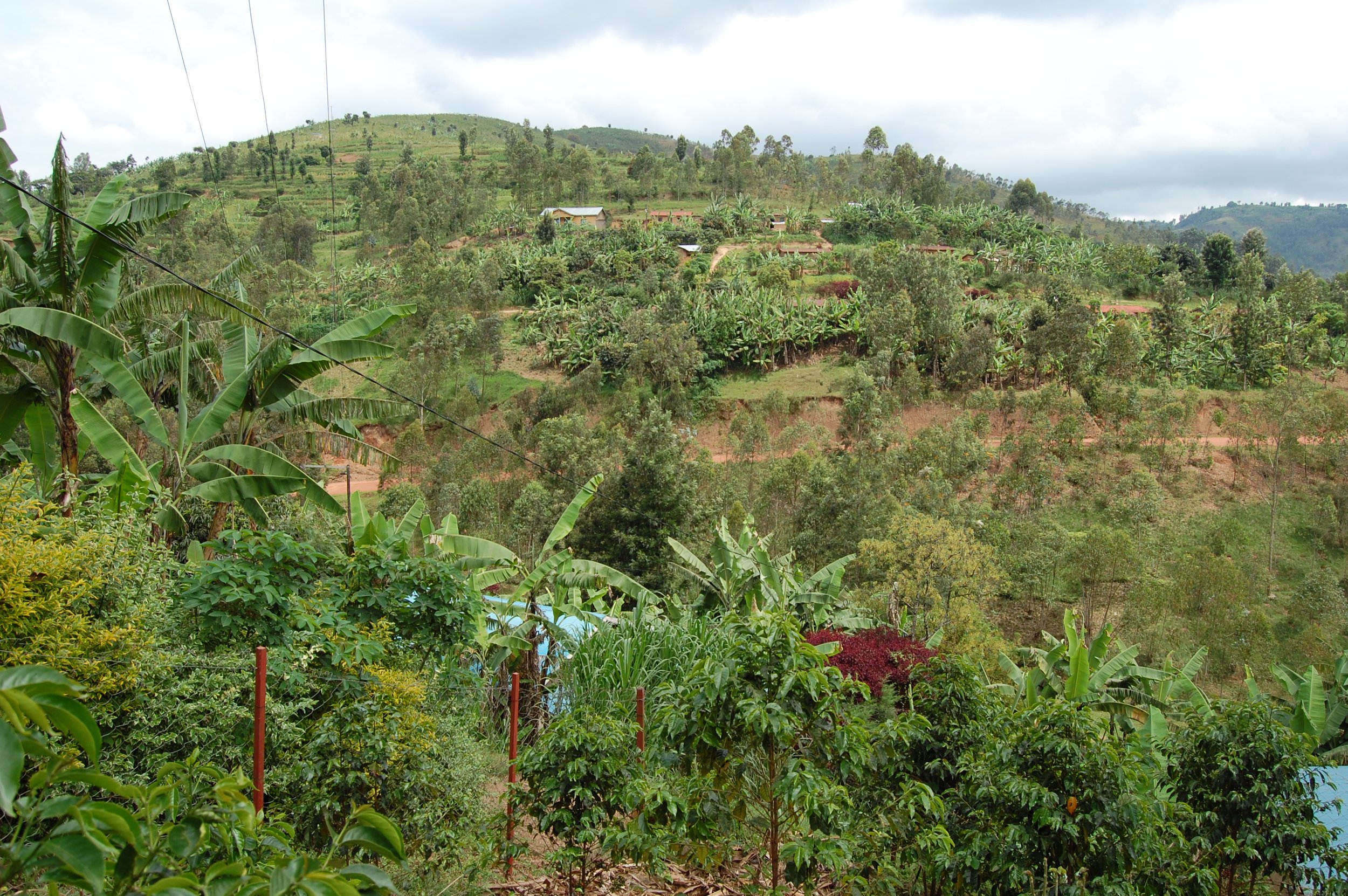The Challenge
Decreasing productivity had become a problem in the Northern regions of Rwanda. Income and nutritional safety were at risk, and a huge part of this problem had to do with soil quality. Without proper soil, how can healthy, good coffee grow? This project was born to improve the soil, but also with the aim to become a demonstration plot, a place of experimentation and analysis that could eventually offer solutions in other regions, to other farmers.
We are sure that with better soil, production, sales, and quality improve; food safety becomes possible. But how can we do so in a system that works? We knew that by implementing some regenerative techniques, we could offer some solutions, and we were willing to give it a try. Our quest was to diminish the threat not only in the livelihoods of coffee farmers in Rwanda, but in the sustainability of the coffee industry in the Netherlands and other countries served by This Side Up.
WHERE :
Abakundakawa Rushashi, Gakenke District - Northern Province, Rwanda
WHAT :
Creating an agroforestry pilot plot to test and showcase the potential of an intercropping system to uncertified coffee farmers.
WHO :
Abakundakawa Rushashi (coop), This Side Up (funder), MVO Nederland (funder), Matthew Gates (agronomist).
TOTAL INVESTMENT : €8.651,99
Goals :
To regenerate and preserve the soil: by creating an agroforestry system, the soil will regenerate and preserve its health for commercial coffee producers.
To increase nutritional and economic security: by creating a well-maintained agroforestry system (intercropping), the diverse elements will provide additional income and nutrition to farmers and the local community (e.g., in the form of fruit).
Capacity building & replicability: the system will act as a demonstration plot where other farmers locally and internationally (via the This Side Up growers network) can learn about applying dynamic agroforestry practices. The system and its key practices will be replicable (with the flexibility to adjust to local context and farmer decision-making) to be scaled up to benefit a greater number of coffee farmers.
Species Used :
Polyscias Fulva
Calliandra
Avocado
Papaya
Maracuja
Mukuna
CONSULTANCY: €4550,00
project coordination, design, planning, baseline research and training of the workers.
Tools: €2445,80
tools to prepare the land, build the nursery and maintain the plot.
seasonal workers: €884,09
seasonal workers to help with the implementation of the project.
Preparation Plot: €423,38
the preparation of the 11ha plot.
Seeds: €348,72
the purchase of seeds to grow seedlings in the nursery.
Project Timeline
The key annual milestones achieved in this regenerative project.
Preliminary visit
January 2019
The preliminary visits allows Matthew to conclude that: “Abakunda Ikawa is a high-capacity cooperative that is more than capable of implementing and scaling a up a complex agroforestry system. We can work together with its leadership and field officers to develop an innovative, integrated, and scalable system for the unique environment of northern Rwanda. If it is within the scope the project, I am particularly excited about the possibility of developing a system that combines cover crops with agroforestry trees.”
the project consolidates
2019 - 2020
The cooperatives’ leadership and field officers begin working in the development of an innovative, integrated, and scalable system for the unique environment of northern Rwanda.
FIRST SEEDLING OUTplanting in Bulima DEMO PLOT
2020-2021
10 Kg of Mucuna puriens (approximately 800 seeds per kg) on pilot site as a cover crops are planted, 10,232 Calliandra calothyrsus and 552 Polyscias fulva trees planted. Nine Farmer Field Schools on the Bulima pilot site engaged.
START OF FOREST DYNAMICS
From 2022
As trees grow and the canopy continues to close, this will be a dynamic and biodiverse coffee- agroforestry system. In most cases the ratio of agroforestry to coffee plants exceeds 1:2. The ground cover and nitrogen fixation provided by Mucuna puriens will be particularly important.
“The project helped us to mitigate some climate change such as heavy rains and sun. Some of those trees, like mucuna, help to fix nitrogen on the soil and to fabricate fertilizers for coffee. We are encouraging farmers to adapt a regenerative approach.”
Background
A more detailed account of the project and how it came to be.
“We have come a long way from the standard coffee monoculture. As trees grow and the canopy continues to close, this will be a dynamic and biodiverse coffee- agroforestry system.
”
THE QUESTION THAT SPARKED IT ALL
We asked ourselves: "How can we implement an agroforestry system that limits the negative ecological impacts of coffee production and increases the economic stability of our coffee value chain in a way that will inspire other farmers to follow?"This led us to join forces with MVO and put into practice the agroforestry design by Tirion Keatinge in 2019. We then contacted Matthew Gates, an on-the-ground agronomist who closely collaborated with Abakundakawa Cooperative, particularly with Antoine and Stanislaus.
To make this project a reality, we designated a piece of land as a ""demonstration plot"." The project's progress would be evaluated in this land, and the challenges considered. It would eventually demonstrate the possibilities of agroforestry and serve as an inspiration to all cooperative members, who could later implement these practices on their own lands.
THE DEMOSTRATION PLOT
Matthew suggested an area of contiguous coffee farms of approximately 11 hectares. This land is on a hill facing the Rushashi washing station and is owned by dozens of cooperative members. He chose this particular plot because the soil was rocky and fairly poor and would ultimately enable us to engage a large number of cooperative members and improve the challenging soils.
Shortly after, Matthews visited Abakundakawa for the first time, and the leadership committee of the cooperative expressed interest in collaborating with us on the project. In the beginning, the project aimed to engage the 56 Farmer Field Schools and to use their established, well-maintained demonstration fields as a way to scale up the system that we develop and to disseminate practical knowledge of agroforestry technologies. So far, we’ve engaged 10 Farm Field Schools and approximately 150 farmers to the project. After some preliminary studies, the cooperative committee also came up with a few suggestions: 1) To intercrop fruit trees to aid farmers with household nutritional security. 2) Cover crops to plant between coffee trees, and 3) shade trees and nitrogen-fixing green manure trees.
WHAT WE BELIEVE IS URGENT AND POSSIBLE
The creation of a food forest or agroforestry system helps the farmers move away from monoculture, deforestation, and artificial additives. It also invites the farmers, or producers, to analyze the system they usually work with and to deal with organic matter in wiser, more integrated ways. Questions relevant to the soil come afloat, and a symbiotic relationship between certain trees, farmers, and plants is born.
Next to planting several trees that store CO2, a more stable microclimate is also created. Heat waves enter the system with a delay due to the coolness of the forest, and frost also has a harder time penetrating the system. Droughts are better absorbed by the storage capacity of the living soil, and erosion is prevented by the roots of the trees. Fewer artificial additives to the soil also mean a clean discharge of water, leading to better drinking water supplies for the farmers themselves and the villages located downhill. There is simply less need to filter out toxins.
A food forest system aims to show that you can have a productive agricultural system without the need for monoculture and deforestation. Planting different plants together in a structural and thoughtful way increases biodiversity, production, and economic stability, as well as a microclimate that can absorb shocks from climate change.
FUTURE PLANS
Some of the next steps include a massive out-planting of Alnus accumulate should take place as quickly as possible, now that the rains have reliably returned. Renew efforts at planting a wider variety of indigenous/forest trees. This is often somewhat dependent on availability through the national seed bank in Huye. Direct seed seeding seems to be a more efficient and economical way of propagating Calliandra than sowing in sacks. Survival rates for both direct sowing and transplanting from tree sacks, however, seem low. Efforts should be made in the upcoming season to extend the system beyond the pilot site.
Project images:
Feel free to use when supporting this initiative.














































































